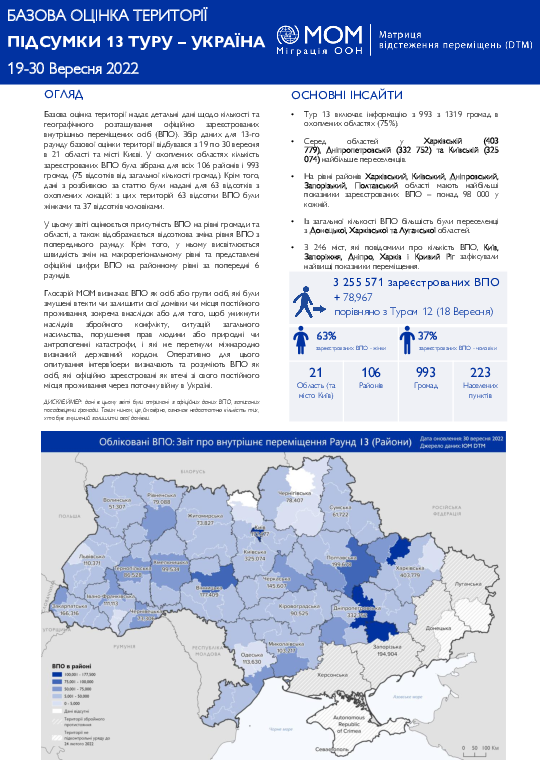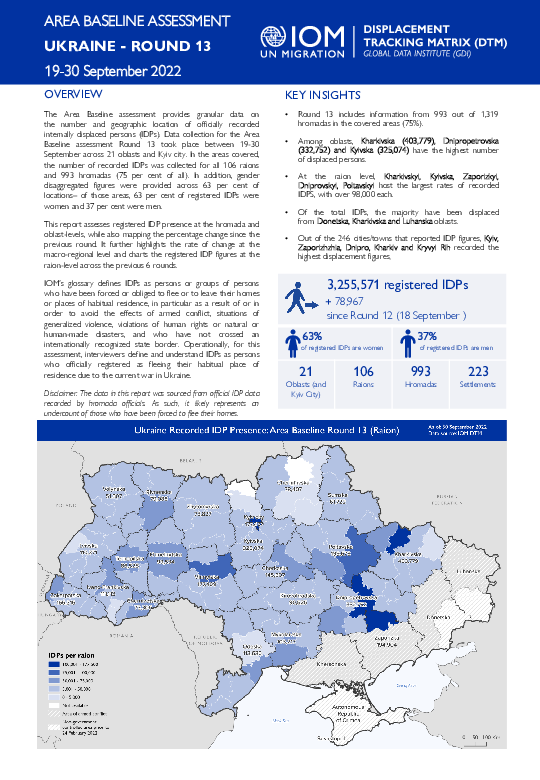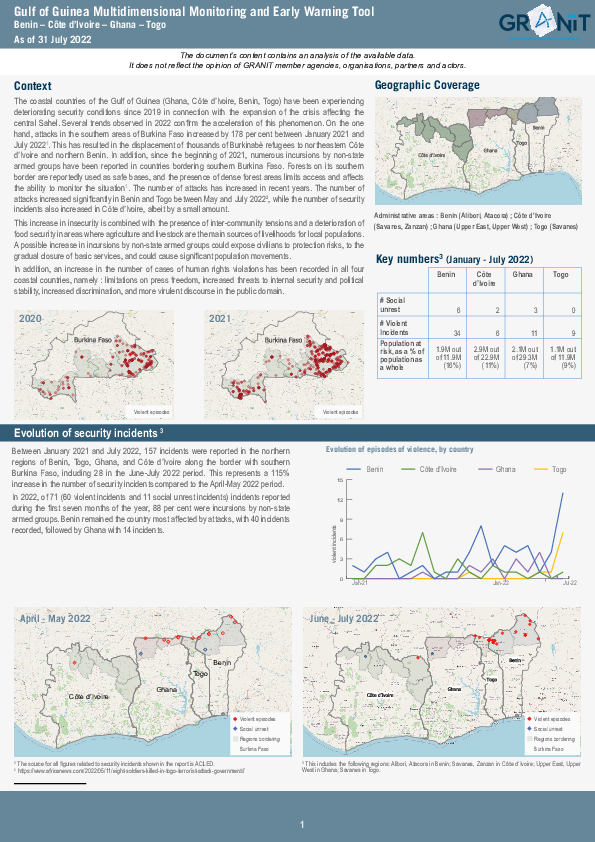-
Countries
-
Data and Analysis
-
Special Focus
-
Crisis Responses

Contact
DTMUkraine@iom.int
Language
Ukrainian
Location
Ukraine
Period Covered
Sep 19 2022
Sep 30 2022
Activity
- Baseline Assessment
Базова оцінка території надає детальні дані щодо кількості та географічного розташування офіційно зареєстрованих внутрішньо переміщених осіб (ВПО). Збір даних для 13-го раунду базової оцінки території відбувався з 19 по 30 вересня в 21 області та місті Києві. У охоплених областях кількість зареєстрованих ВПО була зібрана для всіх 106 районів і 993 громад (75 відсотків від загальної кількості громад). Крім того, дані з розбивкою за статтю були надані для 63 відсотків з охоплених локацій: з цих територій 63 відсотки ВПО були жінками та 37 відсотків чоловіками.
У цьому звіті оцінюється присутність ВПО на рівні громади та області, а також відображається відсоткова зміна рівня ВПО з попереднього раунду. Крім того, у ньому висвітлюється швидкість змін на макрорегіональному рівні та представлені офіційні цифри ВПО на районному рівні за попередні 6 раундів.

Contact
DTMUkraine@iom.int
Language
English
Location
Ukraine
Period Covered
Sep 19 2022
Sep 30 2022
Activity
- Baseline Assessment
The Area Baseline assessment provides granular data on the number and geographic location of officially recorded internally displaced persons (IDPs). Data collection for the Area Baseline assessment Round 13 took place between 19-30 September across 21 oblasts and Kyiv city. In the areas covered, the number of recorded IDPs was collected for all 106 raions and 993 hromadas (75 per cent of all). In addition, gender disaggregated figures were provided across 63 per cent of locations– of those areas, 63 per cent of registered IDPs were women and 37 per cent were men.
This report assesses registered IDP presence at the hromada and oblast-levels, while also mapping the percentage change since the previous round. It further highlights the rate of change at the macro-regional level and charts the registered IDP figures at the raion-level across the previous 6 rounds.
The early warning and monitoring tool on the situation in the Gulf of Guinea coastal countries (Ghana, Benin, Togo and Côte d'Ivoire), as of 31 July 2022, developed by the GRANIT under the direction of OCHA, IOM and REACH, monitors, based on data and analysis provided by humanitarian and development partners, trends relative to key indicators relating to the situation in the four coastal countries, as of 31 July 2022.
This report examines the evolution, over the first five months of 2022, of the situation in Ghana, Togo, Benin and Côte d'Ivoire in terms of :
- Security incidents
- Types and frequency of violence
- Forced displacement of IDPs and Refugees
- Operational status of international borders
- Food security
- Community dynamics
- Human rights

Contact
iombeirut@iom.int
Language
English
Location
Lebanon
Period Covered
May 01 2022
Jul 31 2022
Activity
- Migrants presence
- Mobility Tracking
- Baseline Assessment
This report presents the findings from IOM's Migrant Presence Monitoring (MPM) Round 2 data collection exercise conducted in Lebanon. Data collection took place between May and July 2022 and covered all districts in Lebanon. Through annual rounds, the MPM seeks to systematically assess geographic areas in Lebanon to quantify the presence of migrants. The information is used to support humanitarian assistance, coordination, and planning. The MPM relies on key informants who are mostly composed of migrant community representatives, Mukhtars, and Municipality officials, to provide reliable information in their geographical area. The assessed areas are small enough to ensure that the information collected is as detailed, precise, and reliable as possible. As during the 2021 MPM, data was collected on population size (number of migrants) and nationalities. The 2022 MPM also collected sex and age disaggregated data.
The information from IOM-MPM's findings, complementary to data from past assessments, aims to enable partners across the international community and Lebanese partners to have access to an evidence base on migrant presence, to support well-informed, targeted, and coordinated response. The complementary evidence generated from the MPM exercise also serves as a baseline and tertiary source for triangulation for other data collection exercises. For example, MPM data was used to develop of a sampling frame of migrants for the Multi-Sectorial Needs Assessment (MSNA) 2021 and 2022 exercises led by the Humanitarian Country Team (HCT).
The MPM assessment follows the methodology of IOM’s global Displacement Tracking Matrix (DTM) Mobility Tracking component. Tailored to the operational context in Lebanon, the MPM assessment analyzes data to provide multi-layered information on the presence and mobility of migrants. This assessment aims to complement existing data collection exercises and it is implemented in coordination with key actors to maximize synergies, interoperability and avoid duplication.

Contact
DTM Europe, DTMMediterranean@iom.int
Language
English
Location
Republic of Moldova
Period Covered
Feb 24 2022
Oct 02 2022
Activity
- Flow Monitoring
- Migrants presence
Between 24 February and 2 October 2022, Ukrainian refugees represented 90 per cent (579,582) of all individuals registered at entry from Ukraine (UKR) to the Republic of Moldova (MDA). The remaining 10 per cent (63,867) were Third Country Nationals (TCNs). Similarly, Ukrainian refugees represent 89 per cent (301,971) of all individuals registered leaving the Republic of Moldova towards Romania (ROU) during the reporting period and the remaining 11 per cent (35,730) were TCNs. This report focuses on the observable trends in the data on TCNs who entered the Republic of Moldova from Ukraine and analyzes data concerning their stay or their subsequent movement out of the country.
Contact
DTM Libya, DTMLibya@iom.int
Language
English
Location
Libya
Snapshot Date
Sep 25 2022
Activity
- Site Assessment
Detention Centre Profiling is a component of IOM Libya’s Displacement Tracking Matrix programme. It is a data oriented tool that routinely provides disaggregated sex and age data and key sectoral information on migrants in Libya’s detention centres on the date of assessment.

Contact
DTM Sudan; dtmsudan@iom.int
Language
English
Location
Sudan
Snapshot Date
Sep 20 2022
Activity
- Mobility Tracking
- Event Tracking
The DTM Emergency Event Tracking (EET) is deployed to track sudden displacement and population movements, provide more frequent updates on the scale of displacement, and quantify the affected population when needed. As a subcomponent of the new Mobility Tracking methodology in Sudan (Round Four), and activated on a need basis, EET utilises a broad network of key informants to capture best estimates of the affected population presence per location – a useful tool for humanitarian response planning and design.

Contact
DTM Europe, DTMMediterranean@iom.int
Language
English
Location
Montenegro
Period Covered
May 19 2022
May 31 2022
Activity
- Survey
From 24 February to 31 May, it is estimated that over 74,000 Ukrainians entered the Western Balkans (WB) following the outbreak of the armed conflict in Ukraine. In the same period, nearly 23,000 Ukrainians entered Montenegro, of which nearly 15,000 left the country.
As of 29 May, about 7,700 Ukrainians who have fled the armed conflict were present in Montenegro, a proportionally higher figure than the previous assessment conducted, when about 6,000 Ukrainians were registered in the country. Interestingly, the Ukrainian refugee population currently represents 1.2% of the official Montenegrin population. 3Most of them stay in the coastal area of the country, with friends or relatives or by renting houses/apartments. The cities where there is the greatest presence of Ukrainians are Budva, Bar, Herceg Novi, Tivat and Podgorica.
Between 19 and 31 May, IOM conducted the second rapid displacement and needs assessment in Montenegro in four locations
(Podgorica, Bar, Budva, Herceg Novi) to gather up-to-date information and verify any changes, particularly in terms of the unmet needs of the target population. Compared to the first assessment conducted (available here), this time, the IOM has focused on the coastal area, excluding Bijelo Polje as currently fewer Ukrainians are present there. IOM has decided to focus and prioritize Montenegro as the country continues to have the highest percentage of Ukrainian refugees currently residing in the WB (almost two-thirds of the total Ukrainians present), mainly due to cultural ties, as many have been to the country at other times for tourism reasons or as home/apartment owners but also because the Ukrainian community previously established in the country serves as a pull factor for many fleeing their war-torn homeland. On 13 March 2022, the government of Montenegro issued the decision on granting temporary protection to all persons fleeing Ukraine for a period of one year, renewable. The procedure for obtaining temporary protection should last up to 30 days from the date of submission of the application, during which period, applicants receive a confirmation of submission according to which the most vulnerable categories, such as pregnant women, the chronically ill, children, persons with urgent health problems, can immediately access health care. However, of the 2,530 requests for temporary protection submitted as of March 13, of which 70 per cent adults (76% female and 24% male) and 30 per cent children (of which 23% under 5 years of age), only 434 requests had been resolved.

Contact
DTM Europe, DTMMediterranean@iom.int
Language
English
Location
Montenegro
Period Covered
Mar 30 2022
Apr 06 2022
Activity
- Survey
From 24 February to 06 April, it is estimated that around 40,000 Ukrainians entered the Western Balkans (WB) following the outbreak of the armed conflict in Ukraine. In the same period, an estimated 10,000 Ukrainians entered Montenegro, of which 4,000 left the country. Around 6,000 Ukrainians who fled the armed conflict are currently present in Montenegro. In addition to this, there are around 2,000 Ukrainians who are regular residents of Montenegro. Ukrainian refugees currently represent around 1 per cent of the official Montenegrin population. Most of them are staying in the coastal area of the country, with friends or relatives.
Between 30 March and 06 April, the IOM conducted a rapid displacement and needs assessment in Montenegro in four locations, in Podgorica, Budva, Herceg Novi and Bijelo Polje, to gather more in-depth information on the profiles, intentions and needs of Ukrainians who fled their home country to escape the conflict. The reason for implementing this rapid assessment in Montenegro is that the country has the highest percentage of Ukrainian refugees currently residing in the WB (almost two thirds of the total Ukrainians present). This is mainly due to the cultural linkages with the country, but also to the fact that many Ukrainians have been to the country at other times, having their own house or apartment or having spent the holidays there. On March 13, 2022, the government of Montenegro issued the decision on granting temporary protection to all persons fleeing Ukraine for a period of one year with the possibility of an extension for an additional period. The procedure for obtaining temporary protection lasts up to 30 days from the day the application is submitted.
During this period, applicants receive a confirmation of submission according to which the most vulnerable categories, such as pregnant women, the chronically ill, children, persons with urgent health problems, can immediately access health care
